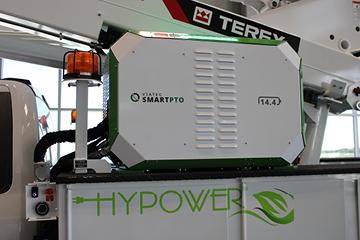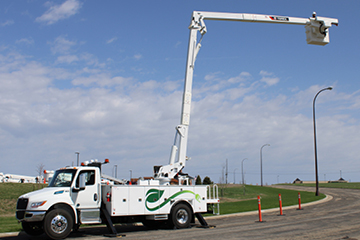Practical Considerations for Distribution Class Electric Trucks
Environmental, Social, and Governance (ESG) sustainability goals are among the key reasons electric utilities are looking for clean, quiet equipment to add to their operations. As original equipment manufacturers (OEMs) work to find solutions to offer the industry, the key question is whether electric and hybrid technology can deliver the expected productivity with efficient operations. That means the technology has to be affordable, easy to maintain, and satisfy operational requirements.
This year Terex Utilities led the way with the introduction of the industry’s first all-electric bucket truck. The EV bucket truck is a Terex Optima 55 ft aerial device, powered by the HyPowerTM SmartPTO by Viatec, on an International® eMV™ Series battery electric 33,000 GVW chassis, from Navistar. It offers a 135-mile driving range and the ability to operate the bucket for a full workday on a single charge.
Terex Utilities decided to target the distribution class with the new EV because, in part, of the predictability of this application. Many distribution trucks undergo day-shift operation and return to a depot at night where they can be recharged. In addition, there are many vehicles in this class, which creates an opportunity to accelerate the overall industry transition to electric vehicles.
An evolving solution from Terex

Terex has been investing in green technology for 15 years. Through the years, battery technology and battery management systems for ePTO solutions have supported product development with lower weights and increased reliability as Terex product solutions have evolved. The all-electric bucket truck has been on the Terex product roadmap for a while – and this year it became a reality.
“With each introduction, it was the right solution with the technology that was available at the time,” said Joe Caywood, director of marketing and product management, in an interview with OEM Off-Highway in July. Now, as technology continues to evolve, we will see range increase, more options integrated, and even all-electric expanding to digger derricks.
Spec’ing an EV bucket truck today
As utilities look to purchase all-electric equipment, there are new specifications to consider and a buyer-education process. Caywood spoke with Utility Fleet Professional in August about some of those issues.
Current battery technology is heavier than what utilities are used to, which limits chassis payload. “So, we’re building the trucks with aluminum bodies and controlling the configuration,” said Caywood, who added that Navistar is making enhancements to the chassis with a bigger front axle.

In addition, the battery’s kilowatt rating is higher than when the ePTO is used in a hybrid configuration with a diesel chassis, which are 14.4 kilowatts or 21 kilowatts. “But on the EVs, we’re going with a 28.8-kilowatt system to power the boom. So, we’re choosing the largest available ePTO battery to give more capacity and ensure the operator can get through a full work day,” said Caywood.
When ordering a truck like this, Terex Utilities has three meetings with fleet managers, so they understand 1) the capabilities of the vehicle, 2) how the chassis and ePTO work together, and 3) what the customer needs to support and maintain the vehicle.
What really matters
At the end of the day, utility professionals want more versatile, productive equipment they can count on to improve efficiency and profitability and features like electrification can help them boost their bottom lines even further.
To find out more about The Terex All-Electric bucket truck, click here.
Blog references:

.png?sfvrsn=cfc0900d_0)